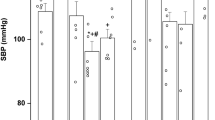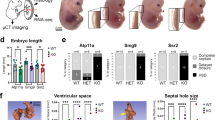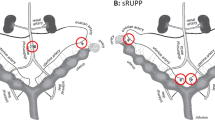Abstract
Survival of newborn placental mammals depends on closure of the ductus arteriosus (DA), an arterial connection in the fetus which directs blood away from the pulmonary circulation and towards the placenta where oxygenation occurs1. Here we show that morphological changes resulting in closure of the DA in mice are virtually identical to those observed in larger mammals, including humans2, and that maintenance of the DA in the open, or patent, state in fetal mice is dependent on prostaglandin synthesis. This requirement is absent in mice lacking the prostaglandin E2 EP4 receptor (EP4(−/−) mice). In EP4(−/−) mice of the 129 strain, remodelling of the DA fails to occur after birth, resulting in a left-to-right shunt of blood and subsequently in death. This suggests that the neonatal drop in prostaglandin E2 (refs 3,4,5,6,7) that triggers ductal closure is sensed through the EP4 receptor. In contrast, 5% of EP4(−/−) mice of mixed genetic background survive, and selective breeding of these mice leads to a 21% survival rate, suggesting that alleles at other loci can provide an alternative mechanism for ductal closure.
This is a preview of subscription content, access via your institution
Access options
Subscribe to this journal
Receive 51 print issues and online access
$199.00 per year
only $3.90 per issue
Buy this article
- Purchase on Springer Link
- Instant access to full article PDF
Prices may be subject to local taxes which are calculated during checkout




Similar content being viewed by others
References
Heymann, M. A. & Rudolph, A. M. Control of the ductus areteriosus. Physiol. Rev. 55, 62–78 (1975).
Jager, B. V. & Wollenman, O. J. An anatomical study of the closure of the ductus arteriosus. Am. J. Pathol. 18 , 595–613 (1942).
Challis, J. R. G., Dilley, S. R., Robinson, J. S. & Thorburn, G. D. Prostaglandins in the circulation of the fetal lamb. Prostaglandins 11, 1041–1046 ( 1976).
Clyman, R. I., Mauray, F., Roman, C., Rudolph, A. M. & Heymann, M. A. Circulating prostaglandin E2concentrations and patent ductus arteriosus in fetal and neonatal lambs. J. Pediatr. 97, 455–461 ( 1980).
Clyman, R. I., Wong, L., Heymann, M. A. & Rudolph, A. M. Responsiveness of the lamb ductus arteriosus to prostaglandins and their metabolites. Prostaglandins 15, 325–331 (1980).
Mitchell, M. D., Brunt, J., Clover, L. & Walker, D. W. Prostaglandins in the umbilical and uterine circulations during late pregnancy in the ewe. J. Reprod. Fertil. 58, 283– 287 (1980).
Piper, P. J., Vane, J. R. & Wyllie, J. H. Inactivation of prostaglandins by the lungs. Nature 225, 600–603 ( 1970).
Patterson, D. F. Genetic factors in persistence of the ductus arteriosus. Paediatr. Cardiol. 2, 45–57 ( 1979).
Gersony, W. M. Patent ductus arteriosus in the neonate. Pediatr. Clin. North. Am. 33, 545–560 ( 1986).
Gittenberger-de Groot, A. C., Strengers, J. L. M., Mentink, M., Poelmann, R. E. & Patterson, D. F. Histologic studies on normal and persistent ductus arteriosus in the dog. J. Am. Coll. Cardiol. 6, 394– 404 (1985).
Jarkovska, D., Janatova, T., Hruda, J., Ostadal, B. & Samanek, M. Effect of prostaglandin E2on the ductus arteriosus in the newborn rat: An ultrastructural study. Physiological Reviews 41, 323–329 ( 1992).
Coceani, F. & Olley, P. M. The response of the ductus arteriosus to prostaglandins. Can. J. Physiol. Pharmacol. 51, 220–225 (1973).
Christiansen, N. C. & Fabricus, J. Medical manipulation of the ductus arteriosus. Lancet 2, 24– 26 (1975).
Elliot, R. B., Starling, M. B. & Neutze, J. M. Medical manipulation of the ductus arteriosus. Lancet 1, 140–142 ( 1975).
Olley, P. M., Coceani, F. & Bocach, E. E-type prostaglandins: A new emergency therapy for certain types of congenital heart malformations. Circulation 53, 728–731 (1976).
Sharpe, G. L., Larsson, K. S. & Thalme, B. Studies on closure of the ductus arteriosus. Prostaglandins 9, 585–596 (1975).
Moise, K. J. et al. Indomethacin in the treatment of premature labor. Effects on the fetal ductus arteriosus. N. Engl. J. Med. 319, 327–331 (1988).
Momma, K. & Takao, A. In vivo constriction of the ductus arteriosus by nonsteroidal anti-inflammatory drugs in near-term and preterm fetal rats. Pediatr. Res. 22, 567 –572 (1987).
Heymann, M. A., Rudolph, A. M. & Silverman, N. H. Closure of the ductus arteriosus in premature infants by inhibition of prostaglandin synthesis. N. Engl. J. Med. 295, 530–533 (1976).
Friedman, W. F., Hirschklau, M. J., Printz, M. P., Pitlick, P. T. & Kirkpatrick, S. E. Pharmacologic closure of patent ductus arteriosus in the premature infant. N. Engl. J. Med. 295, 526–529 ( 1976).
Coleman, R. A., Smith, W. L. & Narumiya, S. International union of pharmacology classification of prostanoid receptors: properties, distribution, and structure of the receptors and their subtypes. Phamacol. Rev. 46, 205 –229 (1994).
Smith, G. C. S., Coleman, R. A. & McGrath, J. C. Characterization of dilator prostanoid receptors in the fetal rabbit ductus arteriosus. J. Pharmacol. Exp. Ther. 271, 390–396 ( 1994).
Coceani, F. Control of the ductus arteriosus — a new function for cytochrome P450, endothelin and nitric oxide. Biochem. Pharmacol. 48 , 1315–1318 (1994).
Clyman, R. I. Ductus arteriosus: Current theories of prenatal and postnatal regulation. Sem. Perinatol. 11, 64– 71 (1987).
Coceani, F. & Olley, P. M. Role of prostaglandins, prostacyclins, and thromboxanes in the control of prenatal patency and postnatal closure of the ductus arteriosus. Sem. Perinatol. 4, 109–113 (1980).
Honda, A. et al. Cloning and expression of a cDNA for mouse prostaglandin E receptor EP2subtype. J. Biol. Chem. 268, 7759–7762 (1993).
Regan, J. W. et al. Cloning of a novel human prostaglandin receptor with characteristics of the pharmacologically defined EP2subtype. Mol. Pharmacol. 46, 213–220 ( 1994).
Engelhardt, J. F., Yankaskas, J. R. & Wilson, J. M. In vivo retroviral gene transfer into human bronchial epithelia of xenografts. J. Clin. Invest. 90, 2598–2607 (1992).
Hooper, M., Hardy, K., Handyside, A., Hunter, S. & Monk, M. HPRT-deficient (Lesch–Nyhan) mouse embryos derived from germline colonization by cultured cells. Nature 326, 292–295 (1987).
Mohn, A. & Koller, B. H. in DNA Cloning 4 (eds Glover, D. M. &Hames, B. D.) 143–184 (Oxford University Press, New York, 1995).
Acknowledgements
We thank B. Anderson and L. Johnson for assistance in cloning the EP4 gene; B. Garges for animal husbandry; A. Latour for help with tissue culture; K. Burns, T. Bartologga and R. Bagnell for assistance with histology and photomicroscopy; and A. Oakely for help with manuscript preparation. This work was supported by grants from Pfizer, the US NHLBI and the NIDDK.
Author information
Authors and Affiliations
Corresponding author
Rights and permissions
About this article
Cite this article
Nguyen, M., Camenisch, T., Snouwaert, J. et al. The prostaglandin receptor EP4 triggers remodelling of the cardiovascular system at birth. Nature 390, 78–81 (1997). https://doi.org/10.1038/36342
Received:
Accepted:
Issue Date:
DOI: https://doi.org/10.1038/36342
This article is cited by
-
Understanding the pathobiology in patent ductus arteriosus in prematurity—beyond prostaglandins and oxygen
Pediatric Research (2019)
-
Hypertrophic osteoarthropathy: estrogens, prostaglandinE2, prostaglandin A2, and the inflammatory reflex
Clinical Rheumatology (2019)
-
Autocrine–paracrine prostaglandin E2 signaling restricts TLR4 internalization and TRIF signaling
Nature Immunology (2018)
-
Detection of QTL for traits related to adaptation to sub-optimal climatic conditions in chickens
Genetics Selection Evolution (2017)
-
Isoprostanes as physiological mediators of transition to newborn life: novel mechanisms regulating patency of the term and preterm ductus arteriosus
Pediatric Research (2012)
Comments
By submitting a comment you agree to abide by our Terms and Community Guidelines. If you find something abusive or that does not comply with our terms or guidelines please flag it as inappropriate.



